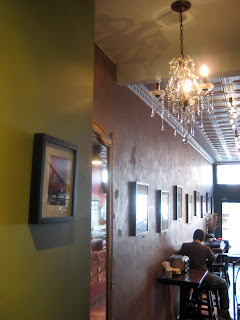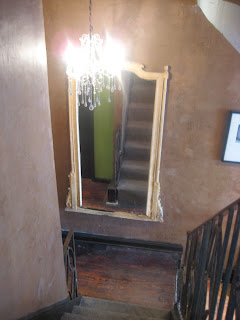The inside is warm. I sip a cup of Rwandan Zirikana and wind my way through 2 floors of what feels like a homey brownstone. Green, maroon and cinnamon-colored walls, velvet and mohair covered sofas and ottomans, portrait photography and dashed canvases on display, Coltrane pumping, chandeliers dotted about above. It's welcoming, but it's empty. I want to know who lives here. It's not long before I find out.
Looking out the window at the tic--tac-toe of new businesses and boarded up buildings, I see a group crowd the door. They're businessmen in their mid 30s, dressed in all black and carrying briefcases. As they enter and approach the barista, one turns to another and says, "So, do you like H Street?". The man replies, "I do, I lived here back in the 90s when it was much worse. Julie is a little less comfortable at night, but the rent is low and it's near Eastern Market. We signed a 16 month lease." As they collect their steaming mugs, a man bundled in a Redskins jacket walks in. He points at another man at the end of the line and bellows, "Hey, why'd you have to look at me through the window like that, man?!" The accused looks at his accuser in fear, unsure of how he should react. The owner takes care of it saying, "Excuse me?", as he stops tamping and emerges from behind the bar. The accuser stares and eventually paces backwards. His hand finds the knob, then he's gone. We sit and stand in silence, contemplating what's just happened.
Where am I? In the heart of the Atlas District, a 3 block stretch on H Street in the NE section of Capitol Hill. The zone is named after the Atlas, the only community-based performing arts center in DC, affectionately called "the people's Kennedy Center". Since it opened in 2006, it has brought new interest and investment to a part of the city that was destroyed by and has struggled to recover from the riots of the late 1960s. With it has come a new demographic - young, educated, upwardly mobile. It is clear that what I have just witnessed is one of many showdowns staged across urban metropoli. The Gentrifiers vs. The Imposed Upon, The Pioneers vs. The Marginalized. In this instance, the latter group is represented by a black man, the former is majority white. The former gets to stay, the latter knew he had to go.
Having lived in the gentrified neighborhoods of Fort Greene and Clinton Hill, Brooklyn, I can tell you it's never as easy as black and white. (Sorry for the cliche.) There are Gentrifiers of all races, including blacks; not every Imposed Upon is poor, angry and confrontational; not every Pioneer is removed and uninvolved in his new community; not every gentrifying business owner is racist. The owner of SOVA asked the man to leave because he was belligerent and potentially hostile, not because he was black. But one can't ignore the history and the realities that have constructed these social conditions, nor the fact that these battles are often waged along color lines.
As resources and money get even tighter, disparate groups will continue to meet and either choose to engage or remain separate. Cafes and other businesses that serve these communities are poised not only to observe these interactions, but mold them and play a significant part in their outcome. SOVA states it "is about and for the community it's in". I hope it's able to serve the community as a whole. I'll be back to find out.





The view from SOVA's windows

H Street Corridor




1 comment:
I love this project and this idea. Go with it. Your descriptions of the place, and its inhabitants.The place itself! Keep at it babe!
Post a Comment